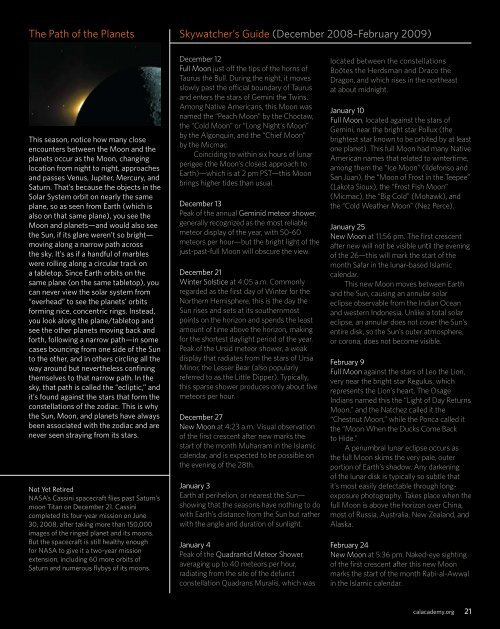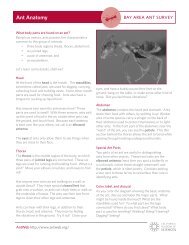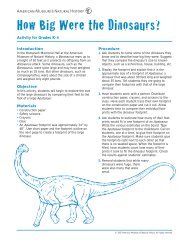Squawk of the town: Academy receives Platinum rating - California ...
Squawk of the town: Academy receives Platinum rating - California ...
Squawk of the town: Academy receives Platinum rating - California ...
You also want an ePaper? Increase the reach of your titles
YUMPU automatically turns print PDFs into web optimized ePapers that Google loves.
The Path <strong>of</strong> <strong>the</strong> Planets<br />
Skywatcher’s Guide (December 2008–February 2009)<br />
This season, notice how many close<br />
encounters between <strong>the</strong> Moon and <strong>the</strong><br />
planets occur as <strong>the</strong> Moon, changing<br />
location from night to night, approaches<br />
and passes Venus, Jupiter, Mercury, and<br />
Saturn. That’s because <strong>the</strong> objects in <strong>the</strong><br />
Solar System orbit on nearly <strong>the</strong> same<br />
plane, so as seen from Earth (which is<br />
also on that same plane), you see <strong>the</strong><br />
Moon and planets—and would also see<br />
<strong>the</strong> Sun, if its glare weren’t so bright—<br />
moving along a narrow path across<br />
<strong>the</strong> sky. It’s as if a handful <strong>of</strong> marbles<br />
were rolling along a circular track on<br />
a tabletop. Since Earth orbits on <strong>the</strong><br />
same plane (on <strong>the</strong> same tabletop), you<br />
can never view <strong>the</strong> solar system from<br />
“overhead” to see <strong>the</strong> planets’ orbits<br />
forming nice, concentric rings. Instead,<br />
you look along <strong>the</strong> plane/tabletop and<br />
see <strong>the</strong> o<strong>the</strong>r planets moving back and<br />
forth, following a narrow path—in some<br />
cases bouncing from one side <strong>of</strong> <strong>the</strong> Sun<br />
to <strong>the</strong> o<strong>the</strong>r, and in o<strong>the</strong>rs circling all <strong>the</strong><br />
way around but never<strong>the</strong>less confining<br />
<strong>the</strong>mselves to that narrow path. In <strong>the</strong><br />
sky, that path is called <strong>the</strong> “ecliptic,” and<br />
it’s found against <strong>the</strong> stars that form <strong>the</strong><br />
constellations <strong>of</strong> <strong>the</strong> zodiac. This is why<br />
<strong>the</strong> Sun, Moon, and planets have always<br />
been associated with <strong>the</strong> zodiac and are<br />
never seen straying from its stars.<br />
Not Yet Retired<br />
NASA’s Cassini spacecraft flies past Saturn’s<br />
moon Titan on December 21. Cassini<br />
completed its four-year mission on June<br />
30, 2008, after taking more than 150,000<br />
images <strong>of</strong> <strong>the</strong> ringed planet and its moons.<br />
But <strong>the</strong> spacecraft is still healthy enough<br />
for NASA to give it a two-year mission<br />
extension, including 60 more orbits <strong>of</strong><br />
Saturn and numerous flybys <strong>of</strong> its moons.<br />
December 12<br />
Full Moon just <strong>of</strong>f <strong>the</strong> tips <strong>of</strong> <strong>the</strong> horns <strong>of</strong><br />
Taurus <strong>the</strong> Bull. During <strong>the</strong> night, it moves<br />
slowly past <strong>the</strong> <strong>of</strong>ficial boundary <strong>of</strong> Taurus<br />
and enters <strong>the</strong> stars <strong>of</strong> Gemini <strong>the</strong> Twins.<br />
Among Native Americans, this Moon was<br />
named <strong>the</strong> “Peach Moon” by <strong>the</strong> Choctaw,<br />
<strong>the</strong> “Cold Moon” or “Long Night’s Moon”<br />
by <strong>the</strong> Algonquin, and <strong>the</strong> “Chief Moon”<br />
by <strong>the</strong> Micmac.<br />
Coinciding to within six hours <strong>of</strong> lunar<br />
perigee (<strong>the</strong> Moon’s closest approach to<br />
Earth)—which is at 2 pm PST—this Moon<br />
brings higher tides than usual.<br />
December 13<br />
Peak <strong>of</strong> <strong>the</strong> annual Geminid meteor shower,<br />
generally recognized as <strong>the</strong> most reliable<br />
meteor display <strong>of</strong> <strong>the</strong> year, with 50-60<br />
meteors per hour—but <strong>the</strong> bright light <strong>of</strong> <strong>the</strong><br />
just-past-full Moon will obscure <strong>the</strong> view.<br />
December 21<br />
Winter Solstice at 4:05 a.m. Commonly<br />
regarded as <strong>the</strong> first day <strong>of</strong> Winter for <strong>the</strong><br />
Nor<strong>the</strong>rn Hemisphere, this is <strong>the</strong> day <strong>the</strong><br />
Sun rises and sets at its sou<strong>the</strong>rnmost<br />
points on <strong>the</strong> horizon and spends <strong>the</strong> least<br />
amount <strong>of</strong> time above <strong>the</strong> horizon, making<br />
for <strong>the</strong> shortest daylight period <strong>of</strong> <strong>the</strong> year.<br />
Peak <strong>of</strong> <strong>the</strong> Ursid meteor shower, a weak<br />
display that radiates from <strong>the</strong> stars <strong>of</strong> Ursa<br />
Minor, <strong>the</strong> Lesser Bear (also popularly<br />
referred to as <strong>the</strong> Little Dipper). Typically,<br />
this sparse shower produces only about five<br />
meteors per hour.<br />
December 27<br />
New Moon at 4:23 a.m. Visual observation<br />
<strong>of</strong> <strong>the</strong> first crescent after new marks <strong>the</strong><br />
start <strong>of</strong> <strong>the</strong> month Muharram in <strong>the</strong> Islamic<br />
calendar, and is expected to be possible on<br />
<strong>the</strong> evening <strong>of</strong> <strong>the</strong> 28th.<br />
January 3<br />
Earth at perihelion, or nearest <strong>the</strong> Sun—<br />
showing that <strong>the</strong> seasons have nothing to do<br />
with Earth’s distance from <strong>the</strong> Sun but ra<strong>the</strong>r<br />
with <strong>the</strong> angle and duration <strong>of</strong> sunlight.<br />
January 4<br />
Peak <strong>of</strong> <strong>the</strong> Quadrantid Meteor Shower,<br />
averaging up to 40 meteors per hour,<br />
radiating from <strong>the</strong> site <strong>of</strong> <strong>the</strong> defunct<br />
constellation Quadrans Muralis, which was<br />
located between <strong>the</strong> constellations<br />
Boötes <strong>the</strong> Herdsman and Draco <strong>the</strong><br />
Dragon, and which rises in <strong>the</strong> nor<strong>the</strong>ast<br />
at about midnight.<br />
January 10<br />
Full Moon, located against <strong>the</strong> stars <strong>of</strong><br />
Gemini, near <strong>the</strong> bright star Pollux (<strong>the</strong><br />
brightest star known to be orbited by at least<br />
one planet). This full Moon had many Native<br />
American names that related to wintertime,<br />
among <strong>the</strong>m <strong>the</strong> “Ice Moon” (Ildefonso and<br />
San Juan), <strong>the</strong> “Moon <strong>of</strong> Frost in <strong>the</strong> Teepee”<br />
(Lakota Sioux), <strong>the</strong> “Frost Fish Moon”<br />
(Micmac), <strong>the</strong> “Big Cold” (Mohawk), and<br />
<strong>the</strong> “Cold Wea<strong>the</strong>r Moon” (Nez Perce).<br />
January 25<br />
New Moon at 11:56 pm. The first crescent<br />
after new will not be visible until <strong>the</strong> evening<br />
<strong>of</strong> <strong>the</strong> 26—this will mark <strong>the</strong> start <strong>of</strong> <strong>the</strong><br />
month Safar in <strong>the</strong> lunar-based Islamic<br />
calendar.<br />
This new Moon moves between Earth<br />
and <strong>the</strong> Sun, causing an annular solar<br />
eclipse observable from <strong>the</strong> Indian Ocean<br />
and western Indonesia. Unlike a total solar<br />
eclipse, an annular does not cover <strong>the</strong> Sun’s<br />
entire disk, so <strong>the</strong> Sun’s outer atmosphere,<br />
or corona, does not become visible.<br />
February 9<br />
Full Moon against <strong>the</strong> stars <strong>of</strong> Leo <strong>the</strong> Lion,<br />
very near <strong>the</strong> bright star Regulus, which<br />
represents <strong>the</strong> Lion’s heart. The Osage<br />
Indians named this <strong>the</strong> “Light <strong>of</strong> Day Returns<br />
Moon,” and <strong>the</strong> Natchez called it <strong>the</strong><br />
“Chestnut Moon,” while <strong>the</strong> Ponca called it<br />
<strong>the</strong> “Moon When <strong>the</strong> Ducks Come Back<br />
to Hide.”<br />
A penumbral lunar eclipse occurs as<br />
<strong>the</strong> full Moon skims <strong>the</strong> very pale, outer<br />
portion <strong>of</strong> Earth’s shadow. Any darkening<br />
<strong>of</strong> <strong>the</strong> lunar disk is typically so subtle that<br />
it’s most easily detectable through longexposure<br />
photography. Takes place when <strong>the</strong><br />
full Moon is above <strong>the</strong> horizon over China,<br />
most <strong>of</strong> Russia, Australia, New Zealand, and<br />
Alaska.<br />
February 24<br />
New Moon at 5:36 pm. Naked-eye sighting<br />
<strong>of</strong> <strong>the</strong> first crescent after this new Moon<br />
marks <strong>the</strong> start <strong>of</strong> <strong>the</strong> month Rabi-al-Awwal<br />
in <strong>the</strong> Islamic calendar.<br />
calacademy.org 21



![download [PDF - 2.7mb] - California Academy of Sciences](https://img.yumpu.com/26596748/1/190x122/download-pdf-27mb-california-academy-of-sciences.jpg?quality=85)








![Download a visitor map [418k] - California Academy of Sciences](https://img.yumpu.com/26596645/1/190x88/download-a-visitor-map-418k-california-academy-of-sciences.jpg?quality=85)



